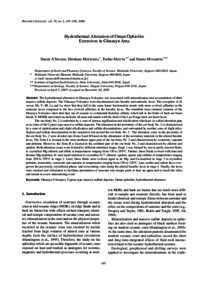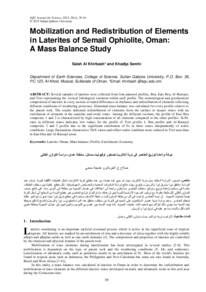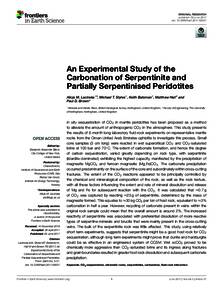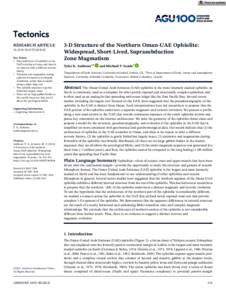Document
Hydrothermal alteration of Oman ophiolite extrusives in Ghuzayn area.
Identifier
DOI: 10.1111/j.1751-3928.2006.tb00277.x
Contributors
Country
Japan
City
Tokyo
Publisher
Society of Resource Geology.
Gregorian
2006-06-01
Language
English
Subject
English abstract
The hydrothermal alteration in Ghuzayn Volcanics was associated with mineralization and accumulation of three massive sulfide deposits. The Ghuzayn Volcanics were discriminated into basaltic and andesitic lavas. The crossplots of Zr versus Nb, Y, Hf, La and Lu show that they fall in the same linear fractionation trends with more evolved affinities in the andesitic lavas compared to the less evolved affinities in the basaltic lavas. The immobile trace element contents of the Ghuzayn Volcanics show that they are of oceanic to continental tholeiitic affinity which fall in the fields of back-arc basin basalt, N-MORB and island arc tholeiite all meet and match with the field of the Lau-Tonga back-arc basin lavas. The ore-body No. 2 is underlain by a zone of intense argillization and silicification which are so-called alteration pipe as in some of the Cyprus-type massive sulfide deposits. The alteration in the proximity of the ore-body No. 2 is characterized by a zone of epidotization and slight silicification and sulfide disseminations, and surrounded by another zone of slight silicification and sulfide dissemination in the outermost rim around the ore-body No. 2. The alteration zones in the proximity of the ore-body No. 2 were divided into Zones I and II based on the abundance of the secondary minerals in the altered basaltic lavas. The Zone I is located in the most northern upper part of the ore-body No. 2 and characterized by corrensite, saponite and prehnite. However, the Zone II is located in the southern part of the ore-body No. 2 and characterized by chlorite and epidote. Both alteration zones were formed by different alteration stages. Stage 1 was formed by non to partly reacted fluids, to crystallize Mg-chlorite and albite at temperatures ranging from 150 to 250°C. Further, these fluids evolved with time and became Mg-depleted, Si- and metal-enriched to crystallize Fe2+-chlorite, epidote, quartz and sulfides at temperatures ranging from 250 to 350°C in stage 2. Later, these fluids were evolved again to be Mg- and Ca-enriched in stage 3 to crystallize prehnite, laumontite, corrensite and saponite at temperatures ranging from 150 to 220°C. Late zeolite and calcite have over-grown the previously crystallized phases and crosscutting veins along the altered basaltic lavas in stage 4. Finally, the lavas were cracked and refractured to facilitate penetration of seawater into deeper parts to heat up again and re-leach the silica and metals in a new mineralizing event.
Description
Resource Geology
Volume 56, Issue 2, 1 June 2006, Pages 167-182
Volume 56, Issue 2, 1 June 2006, Pages 167-182
ISSN
1344-1698
Category
Journal articles




